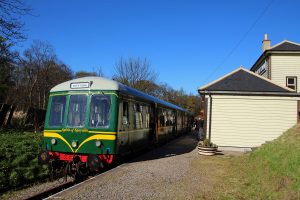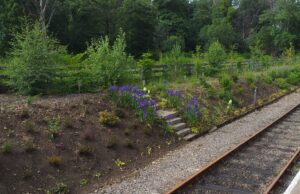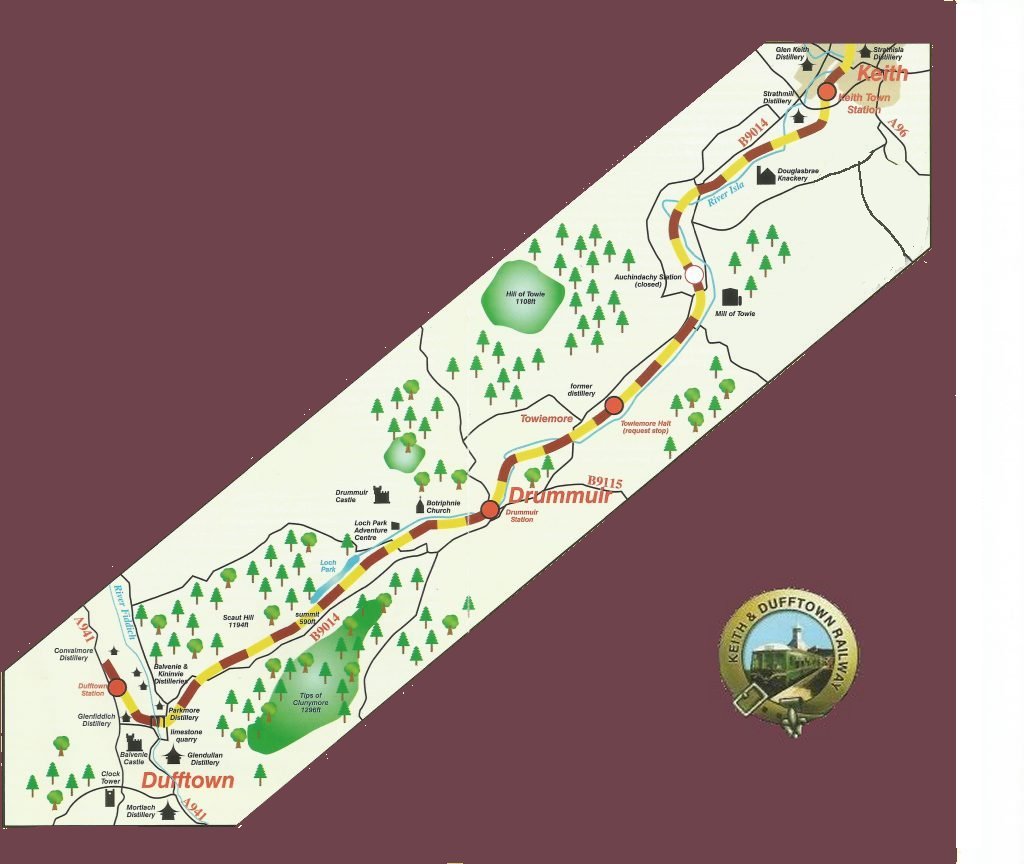DUFFTOWN STATION - Malt Whisky Capital of the World Places to Stay
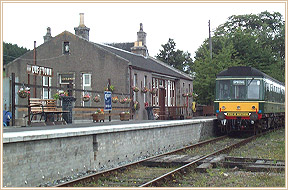
Headquarters and western terminus of the Railway, Dufftown Station, AB55 4BA, is located less than a mile from the town centre towards Elgin on the A941. The Station building has been restored by the Association from a near-ruined shell and now boasts a booking office, museum room and an information area.
The Sidings Café carriages provide excellent café facilities on the platform. Make sure you stop by for a hot snack, tea and coffee, and taste some of Lisa's irresistible home-bakes!
Before we leave on our journey up the line, we will take a moment to discover Dufftown's many visitor attractions.
DUFFTOWN - Local Interest
With seven working distilleries to its name, Dufftown can argue that the title of "Malt Whisky Capital of the World" is justifiably earned! The town was founded in 1817 by the Earl of Fife to relieve unemployment and the quality of its local water sources saw it develop into a major centre for the distilling industry.
Perhaps the most famous of Dufftown's exports is the
Glenfiddich which is the only Highland Single Malt to be distilled, matured and bottled on one site. The distillery, which is alongside the railway at Dufftown, has, for five generations, been run by the Grant family and is open to the public throughout the summer, where the entire process of Whisky making can be viewed - and, of course, tasted!
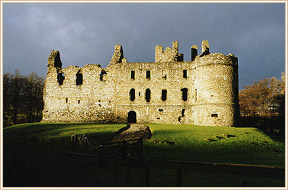
Overlooking the Glenfiddich Distillery are the ramparts of the
13th Century Balvenie Castle, once a home to the Stewarts. It was last occupied in 1746, and has played host to King Edward I of England and Mary, Queen of Scots.
Mortlach church is one of the oldest in Scotland. It is situated just south of the town. The site is thought to have been in use as a place of Christian worship since 566 A.D. and was likely to have been of importance to the Picts long before that.
The Clock Tower is a dominant feature of the town; it was built in 1839 and originally served as the town jail. Choice of overnight
accomodation
(of a much more salubrious nature!) is available for visitors. With the combination of spectacular scenery and the smell of fermenting barley on the air, Dufftown offers its own unique atmosphere!
The Speyside Way offers great opportunities for walkers and is a perfect way to get up close with the natural beauty of the area. It is a 40+ mile, long-distance footpath linking Spey Bay to Tomintoul near Grantown-on-Spey (for the Strathspey Railway), with a branch to Dufftown from Craigellachie. Sounds familiar? Much of the path is on the trackbeds of the Great North of Scotland Railway.
More information on Dufftown and local attractions can be found through the link below
ALL ABOARD! – as we depart Dufftown Station. First we pass the railway's yard on the right; this is currently used for the storage of materials and rolling stock.
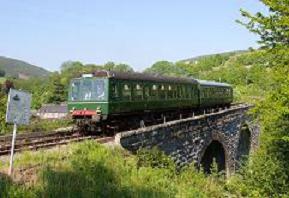
The line curves round past the back of the Glenfiddich Distillery and under the walls of Balvenie Castle before striding out across the Fiddich Viaduct, a superb two arch crossing over the river. The line now begins a steep 1 in 60 climb, past the site of the junction with the branch to Mortlach (later the Parkmore Quarry sidings) and into the narrow valley below the wooded slopes of Scaut Hill.
The climb continues to the summit, at 590ft (180 metres) above sea level; it marks the watershed between the tributaries of the Fiddich, and the source of the River Isla. Dropping away from the summit, the valley opens out and we see, on our left, the waters of Loch Park.
More information may obtained from any of our duty Guards who are always happy to help.
Loch Park is a man-made loch stretching just over a mile along the narrow valley at the head of the Isla. The line drops down to run along the shoreline, hemmed in by the steep pine-covered hillside, until the waters tumble into a circular weir beside the Loch Park Activity Centre.
A halt to serve the Loch Park Centre is a future option. A number of walks, many of which are suitable for wheelchair users, circle the Loch Park and Drummuir area, with access from Drummuir station. For more details see the Drummuir 21 website.
Set between wooded slopes, farmland and loch, the centre offers many outdoor pursuit activities, including mountain biking, orienteering, camping, assault courses and, of course, canoeing and kayaking. See their website for more details.
TO DRUMMUIR
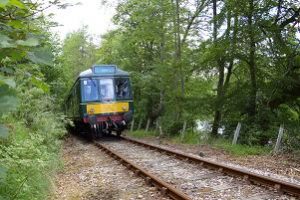
Leaving Loch Park the line winds along beside the infant River Isla as we begin our long descent towards Keith. The towers of Victorian Drummuir Castle are glimpsed on our left before we arrive at Drummuir Station.
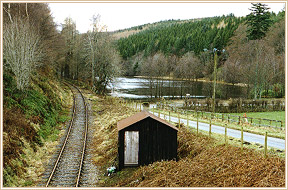
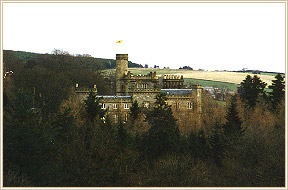
Overlooked by
Drummuir Castle (above). Drummuir Station (below) is the one of the most tranquil spots on the line. Sheltered by the wooded valley sides from the village and road, there is often nothing but birdsong to disturb the natural silence.
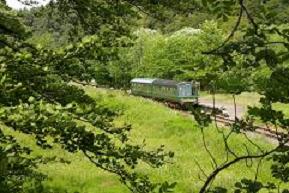
One platform of the original two has so far been refurbished, and the remains of the goods yard loading ramps can still be seen. A passing loop may be re-instated in due course, to allow two trains to run.
Passengers are welcome to break their journey here to stroll through the walled gardens at the nearby castle.
Further all-access walks are available from Drummuir station. For more details see the Drummuir 21 website.
Passengers may, on leaving the train here, walk back along the
Isla WayDrummuir and the nearby Botriphnie Kirk evoke the memory of Saint Fumac, a sixth century saint believed to have been a contemporary of St Columba. Tradition has it that he bathed every morning, summer and winter in waters of the nearby spring. Indeed water from St Fumac's well is still used for baptisms. A new statue in his memory is soon to be erected.
TO TOWIEMORE
Leaving Drummuir, we pass by beautiful native habitats carpeted in summer with the cream coloured flowers of meadowsweet
Filipendula ulmaria . We follow the small Isla river for another mile or so before the main Keith-Dufftown road passes over near a local sawmill.
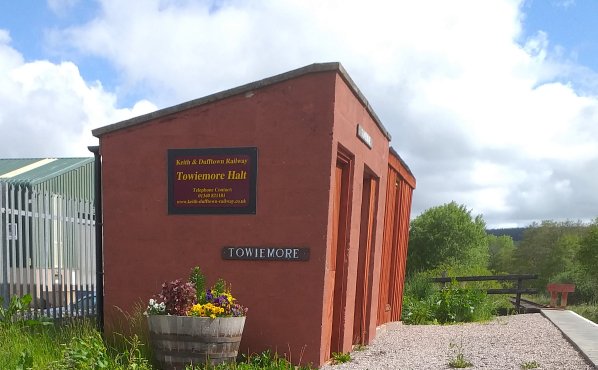
Towiemore Halt has lost its platform over the years, but the former platform hut is now in use as a permanent way store and bothy for cold volunteers! One feature of this station was the use, for many years, of an ex-GNSR coach body as a waiting room. A similar body was acquired several years ago, and one wonders whether it might see similar use again.
The warehouses on the left as we leave the halt were once served by a large goods yard. Clearance work led to the discovery of original GNSR gates still in position amongst the undergrowth. From here the line bends to the left and enters a long straight, parallel with the Isla, now on the right. The landscape is changing as we leave the areas of dense pine forest and enter rolling open farmland.
As the line curves left once again, we pass under the Keith-Dufftown road once more and arrive at Auchindachy station.
Updated 09/06/20
Auchindachy (pronounced och-eye-nachie - soft "ch", as in "loch") Station building still stands, although it is now
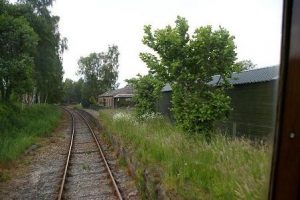
a private residence. One platform of the original two is intact - a fine stand of trees grows where the other used
to be! Across the road from the station is the Mill of Towie, a Victorian watermill complete with waterwheel and
internal fittings. It is, at present, empty, although an attempt was made to open it as a restaurant in recent
years. Perhaps the return of the railway will provide the incentive needed to make the most of this location and
provide an additional attraction for passengers. It is possible that a halt to serve this complex could be
constructed in preference to using the old platform at Auchindachy. This would be on the opposite side of the road
bridge from the existing station.
This area has seen much work put into improving the trackside drains as the line
here is very close to the level of the river, and numerous tributaries feed down from the surrounding hills.
AND DOWN TO KEITH
As we leave Auchidachy the river makes a wide sweep to the right, and the line crosses it twice as it follows
round. The Keith-Dufftown road crosses for the last time as we descend through the picturesque valley towards
Keith. The river meanders below us to the right before passing under us once more on the edge of the town.
Yet another distillery is passed to our left, with Strathmill siding awaiting its next freight traffic. We drop
into the narrow cutting which passes under the main Aberdeen-Inverness road (A96) and out into Keith Town Station,
AB55 5BR.
Keith – with its three distilleries and fascinating history has been named as 'Scotland’s First Scots Toun'. Here are some
places to stay
Located between the River Isla and the Church, Keith Town station, AB55 5BR is surprisingly secluded for a town-centre site. The main road crosses the platform end, but the high-walls of the bridge and pavements mean that there is little intrusion from the modern noise of traffic.
A new station building has been constructed here, based on the original and unique split-level GNSR station building which once stood at the station. The new structure was officially opened in 2003. For the time being, Keith Town is be the effective eastern terminus of the KDR, although the line continues for another half-mile down a steep 1 in 70 gradient to a junction with ScotRail and the Railtrack network at Keith Junction Station. Before we investigate this tantalising link with the mainline, we will stop to investigate the town of Keith in more detail.
KEITH - Local Attractions
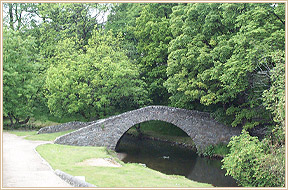
Keith is a market town serving the local agricultural industry - the annual agricultural show is held every August.
It boasts one of the oldest bridges in Scotland, this being the 'Auld Brig', a packhorse bridge built in 1609, and
now close to the Town station.
Scotland's only post-reformation saint,
St John Ogilvie was born here in 1579.
Once
again, there is a strong link with whisky making in the town.
The Strathisla Distillery of Chivas Brothers can be
found next to the Railway line, quarter of a mile down from Keith Town station. It is the oldest distillery in
northern Scotland, dating from 1768, although the waters of the Isla at this point had been used for brewing since
the 13th Century. The distillery is open to the public during the summer.
Further information on Keith and its
surrounding area can be found at: Northern Scot's Moray Visitor Site.
TO THE JUNCTION
The distant signal protecting the Junction approaches still stands at the end of
Keith Town Station, a solitary warning of the former main line junction half a mile ahead.
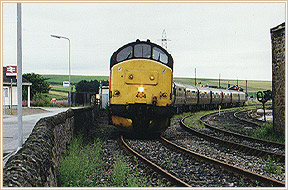
Passing the signal at the end of Keith Town Station, we pass over the River Isla twice as the line winds sinuously
down towards the Junction.
On the right we pass the Strathisla Distillery, home of the Chivas Regal.
When the KDRA took possession of the line, a requirement laid down by Railtrack was that two 60ft panels of track were to be lifted between their headshunt and the start of the branch, and that buffer stops were to be put into position. This was carried out in 1998, isolating the branch from the main line for the first time. The KDRA intends that this link be reopened in the future.
Beyond the bufferstops, the line returns, now in the form of the headshunt from Keith Junction platform. The line sweeps down past the old goods shed and numerous sidings into the branch platform
at Keith Junction Station, (now the mainline station)
This platform is still used by ScotRail services. The Junction Station once boasted four platform faces - one serving the Highland Railway's line from Inverness (now the main line), one serving the GNSR's route to Elgin (via Dufftown) and two Aberdeen-facing bay platforms.
These latter two were removed during the reconstruction of the station and their place is now occupied by the local railway infrastructure company.
The yard still retains its goods shed, sidings and loading areas, although these see infrequent use presently. There is also rail access to the Chivas Brothers plant adjacent although, again, this has not been used recently. The branch platform and headshunt are often used to stable the Royal Scotsman luxury train whilst on its mini-holiday cruises, and occasionally sees the local timber trains side-lined to allow passenger services to pass.
There is scope to reinstate the run-round loop at the branch platform, and this is seen as essential if KDR trains are to connect with their main line counterparts. Use of the yard and shed would also be most welcome in the future.
Main Line Services
ScotRail offers a passenger service from Keith to Aberdeen or Inverness. Train times can be found at the National Rail timetable information site.
Timetables
EWS operate freight services through Keith, mainly timber for the paper making industry.
The End of the Line
We have reached the ultimate terminus of the Keith and Dufftown Railway, having passed through some of the best
scenery to be had in this part of Scotland. There is plenty to see and do along the way, and in time we will see
further attractions develop along the route as the line progresses. And now? There are nine miles of uphill slog
before we reach the summit at Loch Park on the return to Dufftown - that should put any locomotive to the test!
We hope you will join us to take the journey for real on the reopened the line.
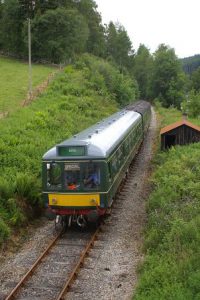

 Overlooking the Glenfiddich Distillery are the ramparts of the 13th Century Balvenie Castle, once a home to the Stewarts. It was last occupied in 1746, and has played host to King Edward I of England and Mary, Queen of Scots.
Overlooking the Glenfiddich Distillery are the ramparts of the 13th Century Balvenie Castle, once a home to the Stewarts. It was last occupied in 1746, and has played host to King Edward I of England and Mary, Queen of Scots.

 Leaving Loch Park the line winds along beside the infant River Isla as we begin our long descent towards Keith. The towers of Victorian Drummuir Castle are glimpsed on our left before we arrive at Drummuir Station.
Leaving Loch Park the line winds along beside the infant River Isla as we begin our long descent towards Keith. The towers of Victorian Drummuir Castle are glimpsed on our left before we arrive at Drummuir Station.

 Overlooked by Drummuir Castle (above). Drummuir Station (below) is the one of the most tranquil spots on the line. Sheltered by the wooded valley sides from the village and road, there is often nothing but birdsong to disturb the natural silence.
Overlooked by Drummuir Castle (above). Drummuir Station (below) is the one of the most tranquil spots on the line. Sheltered by the wooded valley sides from the village and road, there is often nothing but birdsong to disturb the natural silence.

 Towiemore Halt has lost its platform over the years, but the former platform hut is now in use as a permanent way store and bothy for cold volunteers! One feature of this station was the use, for many years, of an ex-GNSR coach body as a waiting room. A similar body was acquired several years ago, and one wonders whether it might see similar use again.
The warehouses on the left as we leave the halt were once served by a large goods yard. Clearance work led to the discovery of original GNSR gates still in position amongst the undergrowth. From here the line bends to the left and enters a long straight, parallel with the Isla, now on the right. The landscape is changing as we leave the areas of dense pine forest and enter rolling open farmland.
As the line curves left once again, we pass under the Keith-Dufftown road once more and arrive at Auchindachy station.
Updated 09/06/20
Towiemore Halt has lost its platform over the years, but the former platform hut is now in use as a permanent way store and bothy for cold volunteers! One feature of this station was the use, for many years, of an ex-GNSR coach body as a waiting room. A similar body was acquired several years ago, and one wonders whether it might see similar use again.
The warehouses on the left as we leave the halt were once served by a large goods yard. Clearance work led to the discovery of original GNSR gates still in position amongst the undergrowth. From here the line bends to the left and enters a long straight, parallel with the Isla, now on the right. The landscape is changing as we leave the areas of dense pine forest and enter rolling open farmland.
As the line curves left once again, we pass under the Keith-Dufftown road once more and arrive at Auchindachy station.
Updated 09/06/20  a private residence. One platform of the original two is intact - a fine stand of trees grows where the other used
to be! Across the road from the station is the Mill of Towie, a Victorian watermill complete with waterwheel and
internal fittings. It is, at present, empty, although an attempt was made to open it as a restaurant in recent
years. Perhaps the return of the railway will provide the incentive needed to make the most of this location and
provide an additional attraction for passengers. It is possible that a halt to serve this complex could be
constructed in preference to using the old platform at Auchindachy. This would be on the opposite side of the road
bridge from the existing station.
This area has seen much work put into improving the trackside drains as the line
here is very close to the level of the river, and numerous tributaries feed down from the surrounding hills.
AND DOWN TO KEITH
As we leave Auchidachy the river makes a wide sweep to the right, and the line crosses it twice as it follows
round. The Keith-Dufftown road crosses for the last time as we descend through the picturesque valley towards
Keith. The river meanders below us to the right before passing under us once more on the edge of the town.
Yet another distillery is passed to our left, with Strathmill siding awaiting its next freight traffic. We drop
into the narrow cutting which passes under the main Aberdeen-Inverness road (A96) and out into Keith Town Station,
AB55 5BR.
a private residence. One platform of the original two is intact - a fine stand of trees grows where the other used
to be! Across the road from the station is the Mill of Towie, a Victorian watermill complete with waterwheel and
internal fittings. It is, at present, empty, although an attempt was made to open it as a restaurant in recent
years. Perhaps the return of the railway will provide the incentive needed to make the most of this location and
provide an additional attraction for passengers. It is possible that a halt to serve this complex could be
constructed in preference to using the old platform at Auchindachy. This would be on the opposite side of the road
bridge from the existing station.
This area has seen much work put into improving the trackside drains as the line
here is very close to the level of the river, and numerous tributaries feed down from the surrounding hills.
AND DOWN TO KEITH
As we leave Auchidachy the river makes a wide sweep to the right, and the line crosses it twice as it follows
round. The Keith-Dufftown road crosses for the last time as we descend through the picturesque valley towards
Keith. The river meanders below us to the right before passing under us once more on the edge of the town.
Yet another distillery is passed to our left, with Strathmill siding awaiting its next freight traffic. We drop
into the narrow cutting which passes under the main Aberdeen-Inverness road (A96) and out into Keith Town Station,
AB55 5BR. 